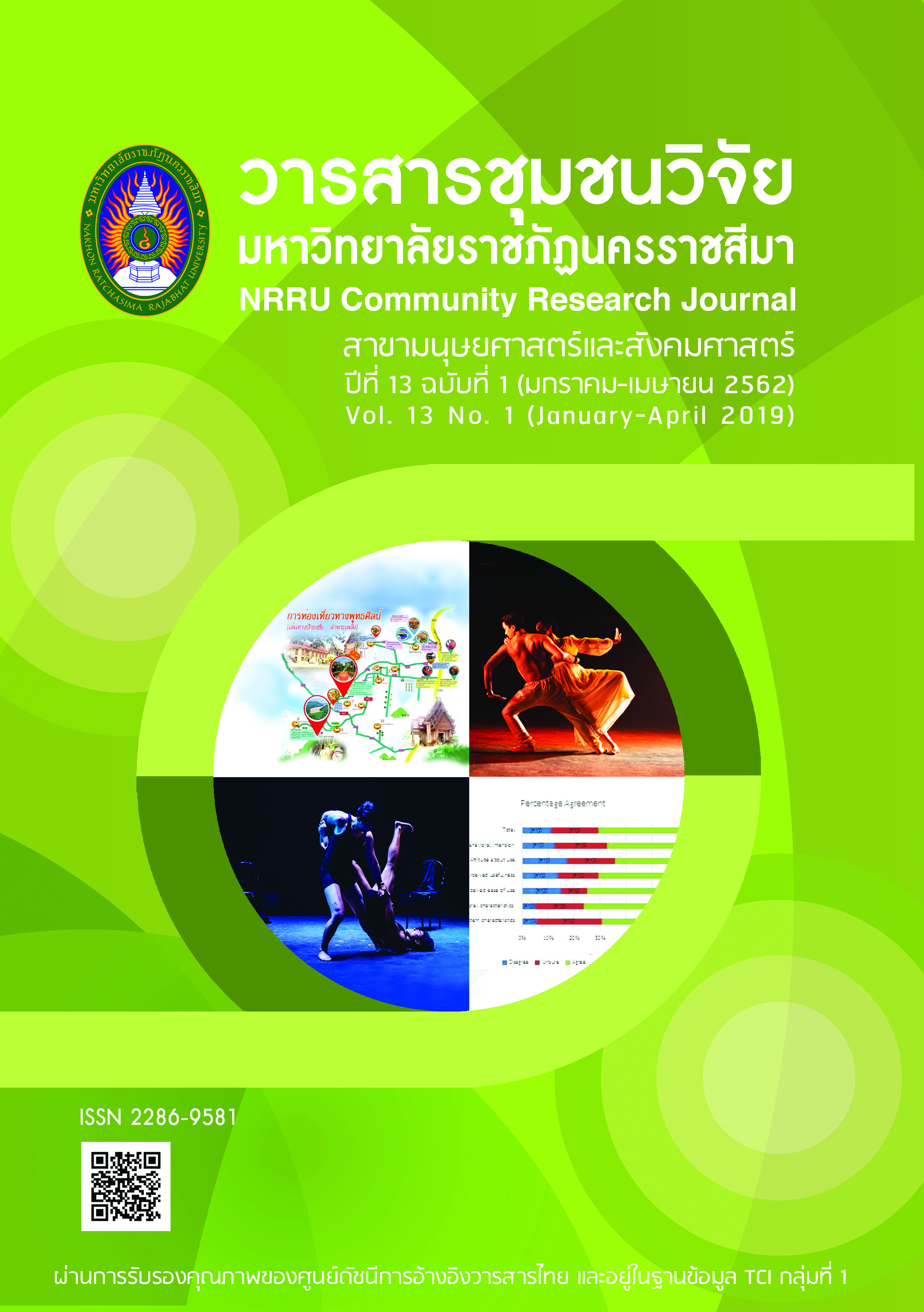รูปแบบการสร้างสรรค์นาฏยศิลป์ จากทฤษฎีสมัยใหม่และหลังสมัยใหม่ทางด้านนาฏยศิลป์
DOI:
https://doi.org/10.14456/10.14456/nrru-rdi.2019.10คำสำคัญ:
รูปแบบการสร้างสรรค์นาฏยศิลป์, ทฤษฎีสมัยใหม่, ทฤษฎีหลังสมัยใหม่บทคัดย่อ
การวิจัยนี้มีวัตถุประสงค์เพื่อค้นหารูปแบบการสร้างสรรค์งานนาฏยศิลป์จากทฤษฎีสมัยใหม่และหลังสมัยใหม่ทางด้านนาฏยศิลป์ ใช้วิธีการศึกษาวิจัยเชิงสร้างสรรค์และวิจัยเชิงคุณภาพที่ผ่านกระบวนการวิเคราะห์ข้อมูลด้วยเครื่องมืองานวิจัย ประกอบไปด้วย ข้อมูลเชิงเอกสาร การสัมภาษณ์ การสังเกตการณ์ สื่อสารสนเทศ การสัมมนา เกณฑ์มาตรฐานศิลปิน และประสบการณ์ส่วนตัวของผู้วิจัย ผลการศึกษาวิจัย พบว่า รูปแบบการแสดงประกอบไปด้วยองค์ประกอบทางนาฏยศิลป์ทั้ง 8 ประการ ได้แก่ 1) บทการแสดงให้ความสำคัญในเรื่องของศิลปินที่เกิดขึ้นในแต่ละยุคสมัย ซึ่งเป็นส่วนสำคัญในการนำแนวคิดต่าง ๆ มาทดลองและสร้างสรรค์ผลงาน จนเกิดเป็นทฤษฎีทางด้านนาฏยศิลป์ โดยแบ่งการแสดงออกเป็น 3 องก์ ประกอบด้วย องก์ 1 ยุคบุกเบิก องก์ 2 ยุคสมัยใหม่ศิลปินรุ่น 1 และรุ่น 2 และองก์ 3 ยุคหลังสมัยใหม่ 2) การคัดเลือกนักแสดง ใช้นักแสดงที่มีความหลากหลายในทักษะการเต้นแบบการเต้นร่วมสมัย และแนวเต้นที่ได้รับความนิยมในปัจจุบัน 3) ลีลานาฏยศิลป์ ใช้ลีลาตามแนวคิดนาฏยศิลป์สมัยใหม่ ได้แก่ แนวคิดการใช้ผ้ากับเทคนิคการใช้แสง แนวคิดฟรีสปิริต (Free spirit) แนวคิดศาสนา (Religion) แนวคิดวัฒนธรรม (Culture) แนวคิดคอนเทรกชัน (Contraction) และ รีลีส (Release) แนวคิดกฎแรงโน้มถ่วงของโลก (Gravity rules of the world) แนวคิดการเต้นที่พื้น แนวคิดหมุนแกว่ง (Swing)และลีลานาฏยศิลป์ตามแนวคิดคิดนาฏยศิลป์หลังสมัยใหม่ ได้แก่ แนวคิดความเรียบง่าย แนวคิดเรื่องความบังเอิญ ยึดติดความไม่เป็นทางการ แนวคิดคอนแทคอิมโพรไวเซชั่น (Contact improvisation) แนวคิดความหลากหลาย การคิดและคำนวณระหว่างแสดง การเพิ่มความเร็วลดความเร็ว4) เสียงและดนตรี ในช่วงเริ่มต้นของการแสดงใช้เสียง ไวโอลิน บรรเลงสดเป็นเสียงหลักเพื่อส่งอารมณ์จากยุคคลาสสิคไปสู่ยุคสมัยใหม่ และใช้เพลงที่แต่งขึ้นใหม่ในแนวหลังสมัยใหม่ด้วยเครื่องอิเล็กทรอนิกส์ 5) อุปกรณ์การแสดง ใช้เก้าอี้วางเป็นส่วนหนึ่งในการแสดงและกำหนดพื้นที่ในการแสดง รวมถึงการใช้ผ้าเป็นอุปกรณ์ประกอบการแสดงบางส่วน 6) การออกแบบพื้นที่การแสดง ใช้ขอบเขตของพื้นที่ในวงกลมและนอกวงกลม โดยใช้เก้าอี้วางเป็นวงกลมกลางเวที เพื่อเป็นการแทนตัวศิลปินที่มีความเชื่อมโยงและมองเห็นทุกคนได้ 7) การออกแบบเครื่องแต่งกาย ใช้ชุดที่ใช้สวมใส่ในชีวิตประจำวันโดยคำนึงถึงความเหมาะสมระหว่างสรีระของผู้แสดงและลีลานาฏยศิลป์ของนักแสดงที่ใช้ทฤษฎีตามแนวคิดของศิลปินเพื่อการเคลื่อนไหวที่เหมาะสม และ 8) การออกแบบแสง ออกแบบเพื่อให้เห็นความเป็นมิติและเส้นสายของร่างกาย โดยใช้แสง สี เงา ให้เหมาะสมกับรูปแบบของลีลานาฏยศิลป์การคลื่อนไหวร่างกายตามแนวคิดของศิลปินยุคสมัยใหม่และหลังสมัยใหม่
เอกสารอ้างอิง
Aranyanak, J. (2018). Design History. Bangkok : Chulalongkorn University Printing School
Chanthaburiphaisan, P. (m.p.p). Dictionary of applied art. Bangkok : Chulalongkorn University.
Chanthanasaro, T. (2014). Dance from the concept of Trinity in Buddhism. Postgraduate Ph.D. thesis. Department of Fine Arts Faculty of Arts Chulalongkorn University, Bangkok.
Charasri, N. (2016). History of Western Dance (2nd edition). Bangkok : Chulalongkorn Printing Press University.
________. (December 18, 2018). Prof. Interview.
Chudum, T. (2008). Exploring the concept of postmodern era. Hatyai Academic Journal, 6(1), 51-64.
Inthanivet, S. (2017). Aesthetics Creative. Bangkok : Sood Phaisan Formula Builder.
Kan, S. (2015). Appropriative Borrowing Art. Bangkok : Chulalongkorn University Printing School.
Kanitphan, R. (2009). Contemporary architectural criticism: theoretical and conceptual development (1970-2003). Research report. Bangkok : Thammasat University.
Krauss, R. E. (1981). Passages in Modern Sculpture (revised ed.), NY : MIT Press.
Lyotard, J. F. (1993). The postmodern condition: A report on knowledge. Manchester, UK : Manchester University Press.
McDonald, C. J. (1991). Creative dance in elementary schools: A theoretical and practical justification. Canadian Journal of Education, 16(4), 434-441.
Nunphakdee, P. (2012). Graphic Design Principles and process of graphic design (2nd ed). Nonthaburi : IDC.
Pitakthepsombat, P. (2007). Sampling by sampling: theory and practice (4th ed). Bangkok : Thammaseman Printing Factory.
Pudnopat, T. (2016). Modern: A Brief History of Art Before the Information Age. Bangkok : Com Public Publishing.
Rosen, J. C. (1995). Cognitive Behavior Therapy for Negative Body Image in Obese Women. BEHABIOR THERARY, 26, 25-42.
Saenai, T, (2016). The creation of women's modern dance affected by the psychological unrest in the southern border of Thailand. Doctor of Philosophy Thesis. Department of Fine Arts Faculty of Arts. Chulalongkorn University, Bangkok.
Sophle, B., & Llsa, M. (2011). What Is Performance Art?. Library : Dublin.
Stokstad, M. (2002). Art History (2nd ed). New York : Prentice Hall Inc. and Harry N. Abrams, Inc.
Suianyathamethi, W. (2014). Development of concepts and styles of Western art. Bangkok : Thammasat University.
Sunphongsri, K. (2013). Aesthetics, philosophy, visual theory Art criticism. Bangkok : Chulalongkorn University.
________. (2015). Modern Art. Bangkok: Chulalongkorn University.
Sunvaraphiphu, T. (2016). The linkage of Western dance aesthetics. Journal of Humanities and Faculty of Science, Bansomdejchaopraya Rajabhat University, 11(2), 91-109.
Tansatei, T. (2014). Teaching materials for art history courses. Chiang Mai : Maejo University.
Thai Royal Academy. (2013). The Royal Institute of Dictionary 2011 (2nd ed). Bangkok : Nanmee Book publication.
Veeraphanphong, A. (2015). Book reviews: The Public Administration Theory Primer by Frederickson, G. and Smith, K.B. Journal of Political Science and Law , Kalasin Rajabhat University, 4(1), 248-255.
Venturi, R. (1977). Learning from Las Vegas : The forgotten symbolism of architectural form. Cambridge, MA : MIT.
Venturi, R., & Brown, C. (1993). Remarques. L’Architecture D’Aujourd’hui, 288(September), 36-37.
Wongchaisuwan, T. (2007). Local Aphiwat. Bangkok: Trai Trait Institute Thanakorn Foundation
Wuthathit, V. (December 12, 2018). Interview.





